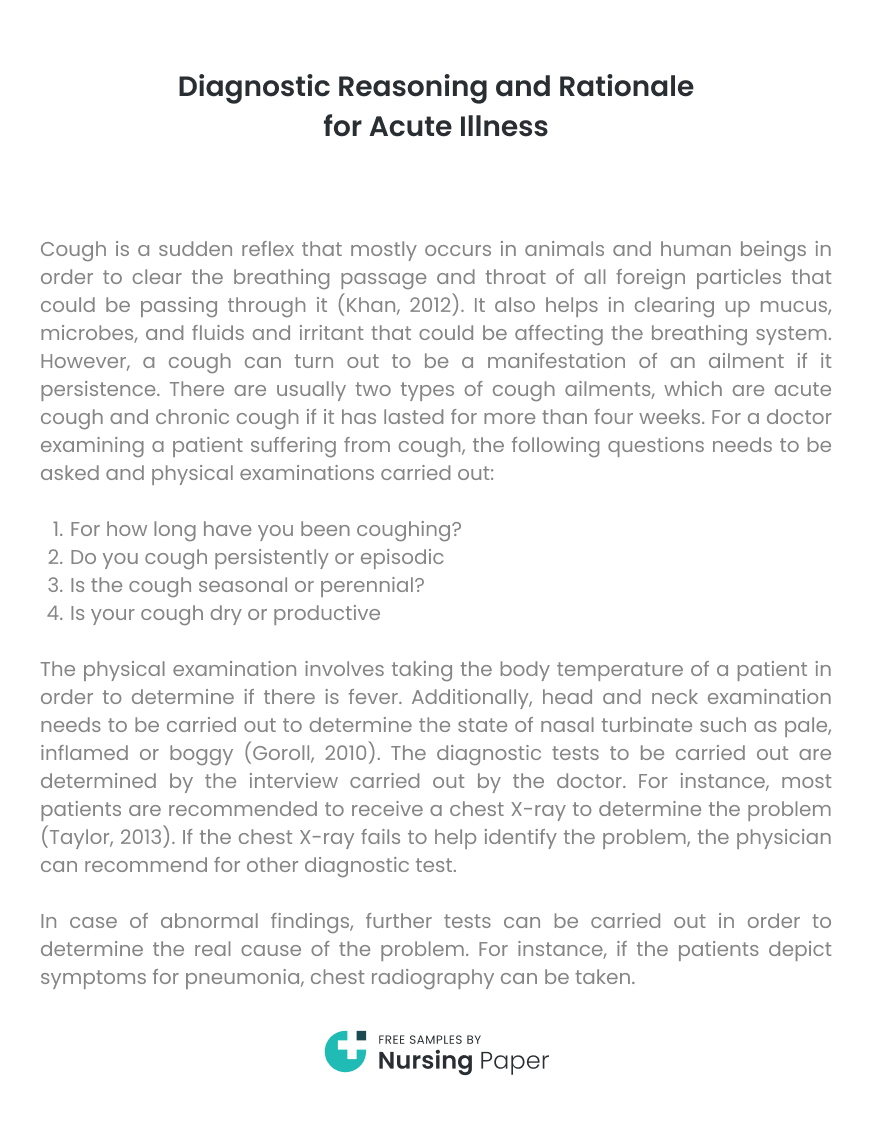
Diagnostic Reasoning and Rationale for Acute Illness
Introduction
Cough is a sudden reflex that mostly occurs in animals and human beings in order to clear the breathing passage and throat of all foreign particles that could be passing through it (Khan, 2012). It also helps in clearing up mucus, microbes, and fluids and irritant that could be affecting the breathing system. However, a cough can turn out to be a manifestation of an ailment if it persistence. There are usually two types of cough ailments, which are acute cough and chronic cough if it has lasted for more than four weeks. For a doctor examining a patient suffering from cough, the following questions needs to be asked and physical examinations carried out:
- For how long have you been coughing?
- Do you cough persistently or episodic
- Is the cough seasonal or perennial?
- Is your cough dry or productive
The physical examination involves taking the body temperature of a patient in order to determine if there is fever. Additionally, head and neck examination needs to be carried out to determine the state of nasal turbinate such as pale, inflamed or boggy (Goroll, 2010). The diagnostic tests to be carried out are determined by the interview carried out by the doctor. For instance, most patients are recommended to receive a chest X-ray to determine the problem (Taylor, 2013). If the chest X-ray fails to help identify the problem, the physician can recommend for other diagnostic test.


Conclusion
In case of abnormal findings, further tests can be carried out in order to determine the real cause of the problem. For instance, if the patients depict symptoms for pneumonia, chest radiography can be taken. Such symptoms include hypoxia, decreased breath sounds and crackles. The list of cough differentials includes; rhinitis caused by physical or chemical irritants, bacterial sinusitis, occupational rhinitis and allergic fungal sinusitis.
1. Goroll, A. H., & Mulley, A. G. (2010). Primary care medicine: Office evaluation and management of the adult patient. Philadelphia: Wolters Kluwer Health/Lippincott Williams & Wilkins.
2. Khan, F., Sachs, H. J., Pechet, L., & Snyder, L. M. (2012). Guide to diagnostic testing. Philadelphia: Lippincott Williams & Wilkins.
3. Taylor, R. B. (2013). Diagnostic principles and applications: Avoiding medical errors, passing board exams, and providing informed patient care. New York: Springer.



The download will start shortly.

The download will start shortly.
 Subject:
Nursing
Subject:
Nursing  Number of pages: 3
Number of pages: 3  Subject:
Medicine
Subject:
Medicine  Number of pages: 6
Number of pages: 6  Subject:
Health and Social Care
Subject:
Health and Social Care  Number of pages: 4
Number of pages: 4  Subject:
Nursing
Subject:
Nursing  Number of pages: 4
Number of pages: 4  Subject:
Nursing
Subject:
Nursing  Number of pages: 2
Number of pages: 2  Subject:
Health and Social Care
Subject:
Health and Social Care  Number of pages: 2
Number of pages: 2  Subject:
Health and Social Care
Subject:
Health and Social Care  Number of pages: 13
Number of pages: 13  Subject:
Nursing
Subject:
Nursing  Number of pages: 3
Number of pages: 3  Subject:
Health and Social Care
Subject:
Health and Social Care  Number of pages: 2
Number of pages: 2  Subject:
Medicine
Subject:
Medicine  Number of pages: 11
Number of pages: 11  Subject:
Health and Social Care
Subject:
Health and Social Care  Number of pages: 3
Number of pages: 3  Subject:
Health and Social Care
Subject:
Health and Social Care  Number of pages: 2
Number of pages: 2  Subject:
Nursing
Subject:
Nursing  Number of pages: 3
Number of pages: 3  Subject:
Nursing
Subject:
Nursing  Number of pages: 5
Number of pages: 5  Subject:
Health and Social Care
Subject:
Health and Social Care  Number of pages: 5
Number of pages: 5 
